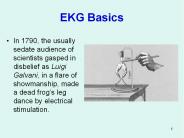Basics -- 2 - PowerPoint PPT Presentation
Title:
Basics -- 2
Description:
From: Data Structures and Their Algorithms, by Harry R. Lewis and Larry ... Suppose we use a phone book to look up a number. Let ... – PowerPoint PPT presentation
Number of Views:23
Avg rating:3.0/5.0
Title: Basics -- 2
1
Basics -- 2 From Data Structures and Their
Algorithms, by Harry R. Lewis and Larry Denenberg
(Harvard University Harper Collins Publishers)
2
Review Logarithms, Powers and Exponentials
Let b be any real greater than 1 and let x be any
real greater than 0. The logarithm to the base b
of x, denoted logbx is defined to be the number y
such that by x logb1 0 logb x gt 0 if x gt
1 logbb 1 logbx lt 0 if 0 lt x lt 1 Any
logarithmic function is a monotone increasing
function of its argument, that is logbx1 gt
logbx2 provided that x1 gt x2
3
Doubling the argument increases the base 2
logarithm by 1. That is, log22x (log2x)
1 Why? 2(log2x) 1 2log2x? 2 2 ?
x 2log22x 2x
4
Review Logarithms logb (x1 ? x2) logb x1
logb (x2) logb (x1 / x2) logb x1 - logb
x2 logb xc c ? logb x
5
Suppose a and b are both greater than 1, what is
the relation of loga x to logb x? Since x
aloga x logbx logb(alogax) logax ?
logba
This is a constant. So, any two logarithmic
functions differ only by a constant factor.
For example, suppose we know that an algorithm
executes lg x instructions, where x is the size
of the input. lg x lg(10log10x) log10x
? lg 10 3.32 log10x
6
The number of bits in the usual binary notation
for the positive integer N is ?LgN? 1. For
example, how many bits are required to
represent 41 0 1 0 1 0 0 1 6 bits ?Lg41?
1 51 6 64 32 16 8 4
2 1 3 0 1 1 2 bits ?Lg3? 1 11
2 4 2 1
7
The number of digits in the usual base 10
notation for the positive integer N is ?Log10N?
1. For example, how many digits are required
to represent 31? 31 3 1 2 digits ?Log1031?
1 11 2 10 1
8
Any function from reals to reals of the form g(x)
x? for some constant ? gt 0 is called a simple
power. Any simple power is an increasing
function of its argument. Examples x2, x3 and
x1/3 are simple powers
9
An exponential function is one of the form h(x)
cx for some constant c gt 1. Examples 2x and
100x are exponential functions of x
10
Dominates
- Let f and g be functions from reals to reals. f
dominates - g if the ratio f(n) / g(n) increases without
bound as n - increases without bound. In other words, if
for any c gt 0 - there is an n0 gt 0 such that f(n) gt c ? g(n)
for all n gt n0. - Examples f(n) n2 dominates g(n) 2n since
for any c - n2 gt c? 2n whenever n gt 2c.
- f(n) 10n does not dominate g(n) 2n since the
ratio of - f(n) / g(n) is never larger than 5.
11
Theorem Any exponential function dominates any
simple power, any simple power dominates any
logarithmic function.
12
Let N be the set of nonnegative integers 0,1,.
Let R be the set of real numbers and let R be
the set of nonnegative real numbers. Let g be a
function from N to R. Then O(g) is the set of
all functions f from N to R such that, for
some constants c gt 0 and N0 ? 0. f(N) ? c ?
g(N) for all N ? N0 . In other words, f ? O(g)
if the value of f is bounded from above by a
fixed multiple of the value of g for all
sufficiently large values of the argument.
13
Examples For any f it is the case that f ?
O(f). Any constant multiple of f is in
O(f). F(n) 13n 7 is in O(n). Why? 13n 7
? 14n for n ? 7 So the definition is satisfied
with c 14, n0 7. 1000n ? O(.0001n2) Why? L
et c 107 and n0 0 in the definition of
O(). f(n) n f(n) ? O(n2)
14
Little
o For any function g, o(g) is the set of all
functions that are dominated by g. That is, the
set of all functions f such that for each
constant c gt 0 there is an n0 gt 0 such
that f(n) lt c ? g(n) for all n gt
n0. Examples Let f(n) n and g(n) n2
then f(n) ? o(g(n)) Let f(n) n2 and g(n)
2n then f(n) ? o(g(n))
15
Theorem Growth Rates
1. The power n? is in O(n?) if and only if ? ? ?
(?, ? gt 0) and n? is in o(n?) if and only
if ? lt ? .
Examples
Intuitively n ? O(n3) n lt n3 n ?
o(n3) n lt n3
16
2. logb n ? o(n?) for any b and ?.
Examples
log10 n ? o(n) log2 n ? o(n1/2)
17
3. n? ? o(cn) for any ? gt 0 and c gt 1.
Examples n2 ? o(4n) n100 ? o(2n)
18
4. loga n ? O(logb n) for any a and b.
log2 n ? O(log10 n) log10 n ? O(log2 n)
19
5. cn ? O(dn) if and only if c ? d, and cn ?
o(dn) if and only if c lt d.
Examples 3n ? O(4n) 3n ? o(4n)
20
6. Any constant function f(n) c is in O(1).
For example A 32-bit add instruction
O(1).
21
Big-O only provides an upper bound. For
example 17n2 ? O(n2) but 17n2 ? O(n37)
17n2 ? O(2n)
22
Big Omega (Big- ?) Big-? notation is exactly
the converse of Big-O notation f ? ?(g) if and
only if g ? O(f). f ? O(g) implies that f grows
at most as quickly as g. f ? ? (g) implies that
f grows at least as quickly as g.
Examples let f(n) n f(n) ?O(n2)
n2 ? ?(n)
23
Big theta (Big ?) ?(f) O(f) ?
?(f) Example Let f(n) 4n then f(n) ?
O(n) f(n) ? ?(n) so f(n) ? ?(n) The set of
functions ?(f) is the order of f.
24
A Quiz
Suppose we use a phone book to look up a number
in the standard way. Let T(n) be the number of
operations (comparisons) required. In the worst
case T(n) ? O(Log N). True or False
Also, in the worst case, T(n) ?
O(n) ______ T(n) ? ?(n)
______ T(n) ? ?(n) ______
25
A Quiz
Suppose we use a phone book to look up a number
in the standard way. Let T(n) be the number of
operations (comparisons) required. In the worst
case T(n) ? O(Log N). True or False
Also, in the worst case, T(n) ?
O(n) True T(n) ? ?(n) False
T(n) ? ?(n) False
26
A Quiz
Suppose we use a phone book to look up a number.
Let T(n) be the number of operations
(comparisons) required. In the best case T(n) ?
O(1). True or False Also, in the
best case, T(n) ? O(n) _____
T(n) ? ?(n) _____ T(n)
? ?(n) _____
27
A Quiz
Suppose we use a phone book to look up a number.
Let T(n) be the number of operations
(comparisons) required. In the best case T(n) ?
O(1). True or False Also, in the
best case, T(n) ? O(n) True
T(n) ? ?(n) False T(n)
? ?(n) False
28
A Quiz
Suppose we want to delete the last item on a
singly linked list. Let T(n) be the number of
operations (comparisons) required. There are no
cases to consider T(n) ? O(n). True or False
T(n) ? O(Lg n) T(n) ?
?(n) T(n) ? ?(Lg n)
29
A Quiz
Suppose we want to delete the last item on a
singly linked list. Let T(n) be the number of
operations (comparisons) required. There are no
cases to consider T(n) ? O(n). True or False
T(n) ? O(Lg n) False
T(n) ? ?(n) True T(n) ? ?(Lg
n) True
30
Remember
When working with Big O, Big ? and Big ?, be
sure to always consider only large n. In
addition, pin the case down first and then
consider Big O, Big ?, and Big ?. Lastly,
remember that some times case does not apply.
31
Algorithms and Problems
In this class, we will mostly be analyzing
algorithms (counting operations) in terms of Big
O, Big ? and Big ?. Problems may also be
analyzed. The lower bound for a particular
problem is the worst case running time of the
fastest algorithm that solves that
problem. Later, we will look at an argument that
comparison based sorting is ?(n Log n). What does
that mean?































